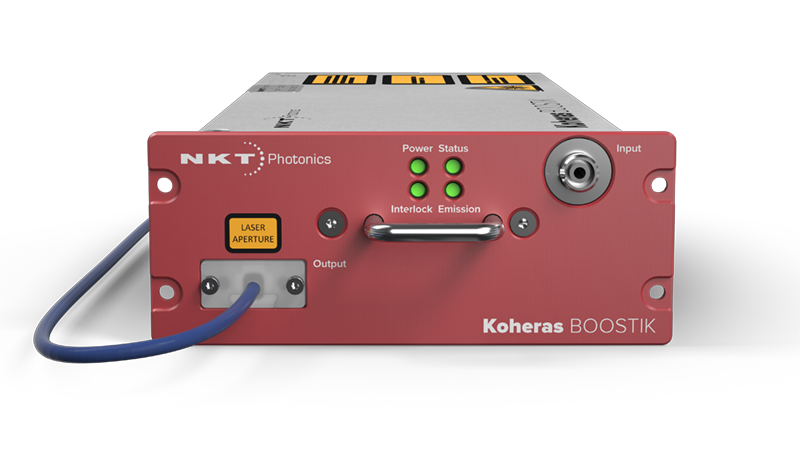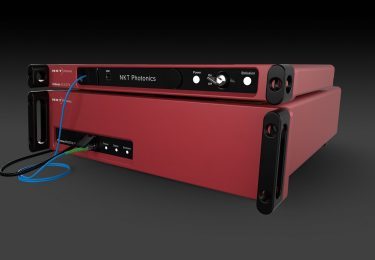Quantum-squeezed laser light shows less noise in the statistics of the detected photons than shot noise, even though shot noise represents the lowest noise of all conventional lasers.
What we call a “squeeze laser” can establish correlations between detected photons. These so-called quantum correlations can be used to:
- improve ultra-sensitive measurements beyond what is possible with conventional ultra-stable laser light
- raise the security of quantum key distribution to a new level
- build optical quantum computers
A “squeeze laser” is a laser that is parametrically pumped below threshold. As pump light, we regularly use Koheras continuous-wave lasers at 1550 nm from NKT Photonics.
First, we frequency-double this light to 775 nm, then use it to pump our squeeze lasers. The squeeze laser is itself an important quantum technology and a key resource for a variety of more specialized quantum technologies.
A portable squeeze laser
The photo below shows a prototype of a portable squeeze laser on a breadboard with the dimensions of 80 cm x 80 cm. A fiber in the right corner connects the NKT Koheras laser with the setup.

To illustrate the innovative potential of squeeze lasers, let’s look at the arrival times of photons. A conventional laser emits noisy photon statistics.
The noise results from the fact that the detected photons obey the probability distribution of mutually independent detection events (“Poisson statistics” or “counting statistics”).
The result is photon shot noise. This shot noise limits the sensitivity of the measurements we perform with conventional lasers, such as the ultra-stable Koheras. Tiny measurement signals cannot be resolved due to shot noise, as illustrated in the left panel of the figure below.
With squeezed light of the same power, the same tiny signal becomes visible, as illustrated in the right panel (the same sinusoidal signal is indeed present in both panels).

The magnitude of the “squeeze factor” we can achieve is a relevant measure of a squeeze laser. It relates to the factor by which the variance of the shot noise is reduced. Factors larger than 10 (> 10 dB) are difficult to achieve and state-of-the-art.
The group of Prof. Dr. Roman Schnabel at Hamburg University has been focusing on the development of squeeze lasers since 2002 and achieved many important milestones since then.
Squeeze lasers for 1550 nm
In 2008, the group reached a squeeze factor of more than 10 for the first time, at 1064 nm. In 2010, the group built the first squeeze laser for a user application. The system was integrated into the gravitational-wave observatory GEO600. This system has been operational ever since. Since 2018, the group has focused on developing squeeze lasers at 1550 nm and achieved a squeeze factor of 13 dB for the first time.
The 1550 nm-wavelength is not only interesting for sensing applications but also in quantum computing and quantum key distribution (QKD). The squeeze laser enhances QKD because any interrogation of the remote measurement device results in a degradation of the quantum correlations that cannot be undone. In this way, squeezed light not only secures the quantum communication channel, but also the remote devices. This is known as one-sided device-independent QKD.
How do the ultra-stable Koheras fiber lasers help us in our research?
They are transverse single modes and can be efficiently matched to a laser resonator. The light shows low levels of power fluctuations, which facilitates a stable control of the pumped squeezing resonator.
Sensing applications require superimposing the squeezed light with conventional light as a carrier beam and require conventional light at the shot-noise level.
The measurement signal scales proportionally to the optical power of the conventional beam. The noise is reduced proportionally to the squeeze factor. The signal-to-noise ratio can thus be optimized with two variables. This combination has been in use in all gravitational-wave observatories since 2019.
We use the ultra-stable Koheras BOOSTIK fiber lasers as pump sources for our squeeze lasers
Institute of Laser Physics University of Hamburg
Meet the authors
Dr. Axel Schönbeck is a researcher at Hamburg University, working on the development of compact and portable squeeze lasers. Having previously done his Bachelor’s, Master’s, and Ph.D. in quantum optics, he is experienced in designing optical systems and putting them into operation. His current work is focused on developing small, portable, and easy-to-operate squeeze lasers to enable their widespread use in quantum technologies. He also works on novel applications for squeeze lasers, collaborating with researchers from other disciplines, e.g., biology.
Prof. Dr. Roman Schnabel is a Professor at the University of Hamburg and head of the Nonlinear Quantum Optics group. He operates twelve high-quality laser laboratories in which his master’s students, doctoral students, and postdocs conduct research on and with squeeze lasers of wavelengths 800 nm, 1064 nm, 1550 nm, and 2128 nm. Based on his 20 years of pioneering work, all current gravitational wave observatories are now equipped with squeeze lasers.






